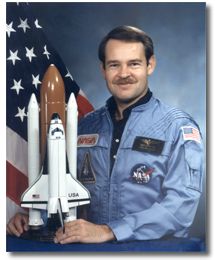- John Oliver Creighton
Infobox Astronaut
name =John Oliver Creighton
type =Astronaut
nationality =American
date_birth =Birth date and age|1943|4|28
place_birth =Orange, Texas
occupation =Test Pilot
rank =Captain , USN
selection =1978 NASA Group
time =16d 20h 24m
mission =STS-51-G ,STS-36 ,STS-48
insignia =John Oliver Creighton (born
April 28 ,1943 inOrange, Texas )is a formerNASA Astronaut who flew threespace shuttle missions.NASA experience
Selected as an astronaut candidate by NASA in January 1978, Creighton became an astronaut in August 1979. During the following four years he held a variety of technical assignments in support of the Space Shuttle Program. Following his first flight, Creighton became the astronaut representative to the Shuttle Program Manager. During the ensuing two years, Creighton participated in all the key decisions following the Challenger disaster helping to shape the plan for resuming safe manned space flight. Starting with
STS-26 , Creighton served as Lead "CAPCOM" for the first four Space Shuttle flights. In March 1989 he was assigned to command STS-36 but continued to serve as Head of the Mission Support Branch in the Astronaut Office until commencing full time training for his upcoming flight. Following his second flight, Creighton headed up the Operations Development Branch within the Astronaut Office for one year prior to resuming full-time training for his next command. Creighton served as pilot on STS-51G (June 17 -24, 1985), was spacecraft commander on STS-36 (February 28 toMarch 4 1990 ) and STS-48 (September 12 -18, 1991), and has logged over 403 hours in space. Captain Creighton left NASA and retired from the Navy in July 1992. He is currently a Test Pilot withBoeing Airplane Company.pace flight experience
STS-51-G Discovery (June 17 -24, 1985) was a 7-day mission during which the crew deployed communications satellites for Mexico (Morelos), theArab League (Arabsat), and the United States (AT&T Telstar ). They used the Remote Manipulator System (RMS) to deploy and later retrieve the SPARTAN satellite which performed 17 hours of x-ray astronomy experiments while separated from the Space Shuttle. In addition, the crew activated the Automated Directional Solidification Furnace (ADSF), six Getaway Specials, participated in biomedical experiments, and conducted a laser tracking experiment as part of theStrategic Defense Initiative . Mission duration was 112 earth orbits in 169 hours and 39 minutes.STS-36 Atlantis (February 28 toMarch 4 1990 ) carried Department of Defense payloads and a number of secondary payloads. Mission duration was 72 earth orbits in 106 hours, 19 minutes, 43 seconds.STS-48 Discovery (September 12 -18, 1991) was a 5-day mission during which the crew deployed theUpper Atmosphere Research Satellite (UARS) which is designed to provide scientists with their first complete data set on the upper atmosphere's chemistry, winds and energy inputs. The crew also conducted numerous secondary experiments ranging from growing protein crystals, to studying how fluids and structures react in weightlessness. Mission duration was 81 earth orbits in 128 hours, 27 minutes, 34 seconds.Military experience
Creighton started flight training following graduation from the U.S. Naval Academy and received his wings in October, 1967. He was with VF-154 from July 1968 to May 1970, flying F-4J's and made two combat deployments to Vietnam aboard the USS "Ranger". From June 1970 to February 1971, he attended the U.S. Naval Test Pilot School at
Patuxent River, Maryland , and upon graduation was assigned as a project test pilot with the Service Test Division at the Naval Air Station Patuxent River. During this two year tour of duty, he served as the F-14 engine development project officer. In July 1973, Creighton commenced a four year assignment with VF-2 and became a member of the first F-14 operational squadron, completing two deployments aboard the USS "Enterprise" to the Western Pacific. He returned to the United States in July 1977 and was assigned to the Naval Air Test Center's Strike Directorate as operations officer and F-14 program manager. He has logged over 6,000 hours flying time, the majority of it in jet fighters, and has completed 500 carrier landings and 175 combat missions.Personal information
Born
April 28 ,1943 , inOrange, Texas , but considersSeattle, Washington , to be his hometown. Married to the former Terry Stanford ofLittle Rock, Arkansas . Recreational interests include skiing, tennis and boating. His mother, Mrs. C. Alberta Creighton, resides in Seattle, Washington. Terry's parents, Helen and Jim Stanford, reside in Stone Mountain, Arkansas.Education
Graduated from Ballard High School,
Seattle, Washington , in 1961; received a bachelor of science degree from theUnited States Naval Academy in 1966 and a master of science in Administration of Science and Technology fromGeorge Washington University in 1978.Organizations
Member of the
Society of Experimental Test Pilots and theAssociation of Space Explorers .pecial honors
Awarded the
Defense Superior Service Medal ,Legion of Merit , Distinguished Flying Cross, 10 air Medals, the Armed Forces Expeditionary Medal, theVietnam Cross of Gallantry , the NASA Distinguished Service & Leadership Medal, 3 United States Space Flight Medals, the French Legion of Honor and the Saudi Arabia King Fahd Medal.ee also
References
*NASA Astronaut Biographies [http://www.jsc.nasa.gov/Bios/htmlbios/creighton-jo.html]
*cite web |last = |first = |authorlink = |coauthors = |year = |url =http://www.scouting.org/Media/FactSheets/02-558.aspx |title =Astronauts and the BSA |format = |work =Fact sheet |publisher =Boy Scouts of America |accessdate =2006-09-06
* [http://www.spacefacts.de/bios/astronauts/english/creighton_oliver.htm Spacefacts biography of John O. Creighton]
Wikimedia Foundation. 2010.
